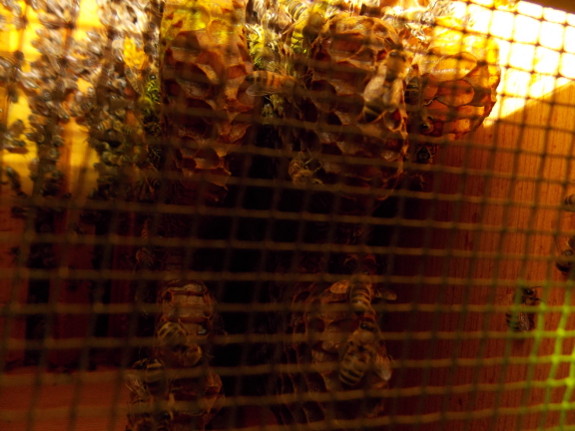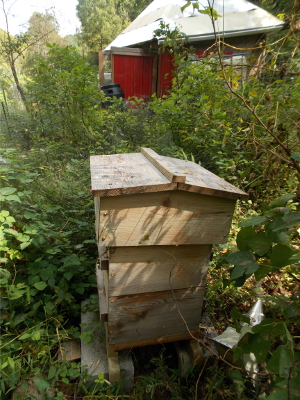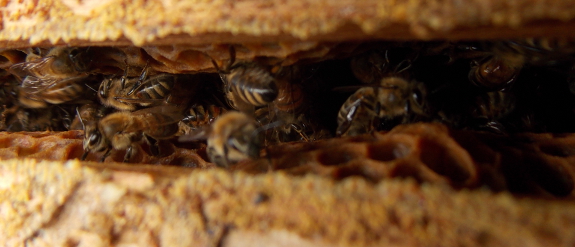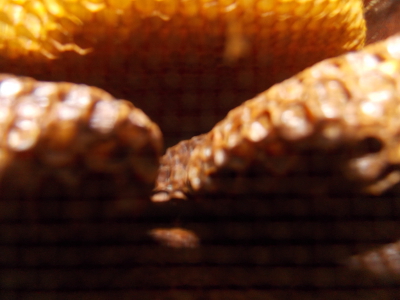
No honey to rob

 It
seems like there's never as much honey in my Warre hives as I think
there is. I went out to rob the mother hive's top box on a sunny
afternoon this week...and found that there was nothing to steal.
The fourth box was empty, the box below contained a good bit of honey
but also some capped brood (meaning it had to be left alone), I didn't
dig into the third box (but I hope it's also full of honey and brood),
and the bottom box consists of partially drawn comb (photo above).
So, instead of stealing honey, I took away the empty top box, and will
probably remove the bottom box later as well.
It
seems like there's never as much honey in my Warre hives as I think
there is. I went out to rob the mother hive's top box on a sunny
afternoon this week...and found that there was nothing to steal.
The fourth box was empty, the box below contained a good bit of honey
but also some capped brood (meaning it had to be left alone), I didn't
dig into the third box (but I hope it's also full of honey and brood),
and the bottom box consists of partially drawn comb (photo above).
So, instead of stealing honey, I took away the empty top box, and will
probably remove the bottom box later as well.
Of course, you don't really expect to harvest honey if you split a hive,
so just having enough bees and stores to get the mother hive through
the winter is good. Luckily, two boxes full of brood and honey are
supposed to be enough for a Warre hive, according to the experts,
unless you live in the far north. Since a Warre hive box is only
the size of a shallow super, that seems counterintuitive to those
of us who started with Langstroth hives, but I'm willing to bow to
wiser beekeepers, who report that the superior insulating ability of
the Warre hive allows the bees to thrive with fewer stores.

Unfortunately, the
daughter hive is also not doing as well as I'd hoped, and they may
actually be in trouble. I removed the third box (empty) and
finally got a look in the second  box,
which turns out to be full of drawn comb but absolutely empty of life
(photo to the left). That means I need to feed fast to get the
bees through the winter.
box,
which turns out to be full of drawn comb but absolutely empty of life
(photo to the left). That means I need to feed fast to get the
bees through the winter.
More troublesome was the
presence of wax moth larvae under the quilt when I peeled back the final
piece of burlap. Wax moths are usually a sign of a hive in
decline, since they mean the colony isn't strong enough to patrol their
entire territory. I hope that feeding the bees will be enough to
let them bulk up and defeat the moths, but realize that there's a good
chance the daughter hive might perish over the winter.
While I'm thrilled that my hives seem to be bypassing varroa mites without chemicals,
I'm still not sold on Warre hives being the way to go --- I'd like to
harvest some honey sooner rather than later. Unfortunately, my
past experience has been Langstroth hives with conventional bees that
produced honey but perished without chemicals or Warre hives with
chemical-free bees that don't produce honey but do survive in a natural
setting. Time to shake things up next year, maybe trying out
chemical-free bees in a Langstroth hive on foundationless frames to see
if those would give us a harvest in a natural setting. I'd love to
hear from other beekeepers who have figured the puzzle out, in case you
want to save me a few more years of trial and error!
Want more in-depth information? Browse through our books.
Or explore more posts by date or by subject.
About us: Anna Hess and Mark Hamilton spent over a decade living self-sufficiently in the mountains of Virginia before moving north to start over from scratch in the foothills of Ohio. They've experimented with permaculture, no-till gardening, trailersteading, home-based microbusinesses and much more, writing about their adventures in both blogs and books.
Want to be notified when new comments are posted on this page? Click on the RSS button after you add a comment to subscribe to the comment feed, or simply check the box beside "email replies to me" while writing your comment.

Hi Anna,
Tales of your beekeeping are my favorite part of Walden Effect. My husband and I just uncorked a bottle of meade; our valediction to summer. After almost two years, it is pleasant. This bee season was again challenging in new and various ways. I'll send you an email with details.